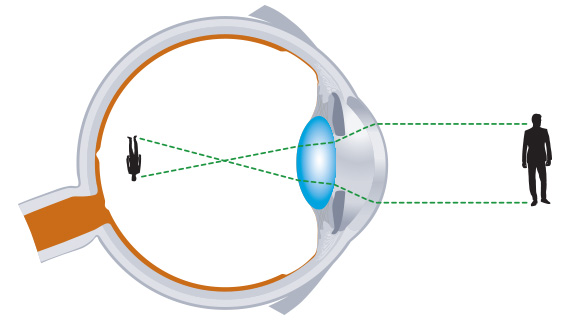 Myopia, also known as nearsightedness or shortsightedness, is a common condition that makes it difficult to see distant objects clearly. This means street signs, TV screens, or your child’s classroom board may be fuzzy.
Myopia, also known as nearsightedness or shortsightedness, is a common condition that makes it difficult to see distant objects clearly. This means street signs, TV screens, or your child’s classroom board may be fuzzy.
Unfortunately, myopia affects millions of people worldwide, with up to 30% of individuals experiencing it in the United States. It occurs when the eye grows too long or the cornea and lens are too curved, causing images to focus in front of the retina instead of on it.
While mild myopia (below -3.00) may not pose significant risks, it can still be inconvenient, as you or your child may need glasses or contact lenses for clear vision. However, for around 10% of people, myopia worsens over time and can lead to severe vision loss, making it a degenerative disorder.
Myopia also increases the risk of developing conditions like cataracts, glaucoma, and retinal detachment later in life. The good news is that myopia management is possible. By partnering with Lang Family Eyecare and making smart lifestyle choices, you and your children can regain clear vision while reducing your chances of developing these eye diseases.
 What Is Myopia?
What Is Myopia?
Nearsightedness, or myopia, occurs when faraway objects become blurry due to a refractive error in the way the eyes focus light. This happens when light focuses in front of, rather than on, the retina at the back of your eye.
Symptoms of Myopia
Be on the lookout for these telltale signals in you or your children:
- Blurred distance vision
- Constantly squinting for clarity
- Experiencing eye strain or tiredness
- Headaches or migraines
High Myopia
Severe nearsightedness, or high myopia, may come with additional risks. Those affected could face complications like retinal detachment, a serious condition that requires immediate attention.
Causes of Myopia
 The precise cause of myopia remains a mystery, but evidence suggests a genetic link and environmental factors. Individuals with nearsighted parents have a higher likelihood of developing myopia. Moreover, lifestyle factors, such as prolonged screen time and intense close visual work, can also play a role. In fact, excessive smart device usage alone increases the risk by 30%, and when combined with extensive computer use, the risk skyrockets to 80%.
The precise cause of myopia remains a mystery, but evidence suggests a genetic link and environmental factors. Individuals with nearsighted parents have a higher likelihood of developing myopia. Moreover, lifestyle factors, such as prolonged screen time and intense close visual work, can also play a role. In fact, excessive smart device usage alone increases the risk by 30%, and when combined with extensive computer use, the risk skyrockets to 80%.
How to Stop Myopia From Worsening
Although your myopia may not be curable, there are steps you or your child can take to stop the progression of myopia and improve your quality of life.
Multifocal Contact Lenses
Dual-focus contact lenses have proven to be effective in controlling myopia for most patients. Research has shown that these lenses can significantly slow down myopia progression, with reductions ranging from 50% to 87.5%.
Using multifocal soft contact lenses can provide numerous benefits for myopic children. Not only do they eliminate the need for glasses or long-term medication, but they can also improve your child’s quality of life by enhancing their visual experience, self-esteem, and athletic performance.
Contact lens use in children may raise concerns for some parents, but with proper education on wear time, lens modality, and hygiene, the risk of adverse events like microbial keratitis can be reduced. Your Lang Family Eye Care doctor will make sure you are fully informed about the use of your or your child’s multifocal contact lenses.
It’s important that you work with a knowledgeable doctor like those at Lang Family Eye Care, since choosing the right multifocal contact lens parameters is crucial for successful myopia control. Factors such as wear time, add power, and pupil size can vary between patients and can affect the fitting and clinical outcomes of contacts for myopia control. We recommend aiming for a minimum of six hours of wear time per day for most people.
Soft multifocal contact lenses are a promising option that Lang Family Eye Care offers for myopia control. Contact us if you are interested in exploring this option for you or your child.
Atropine Eye Drops
Atropine is a versatile medication used in general medicine, as well as in eye care. Eye drops with atropine serve multiple purposes. First and foremost, it can dilate the pupil to aid in testing the vision of a child’s eyes. Additionally, it is effective in treating amblyopia (commonly known as lazy eye) and several other eye diseases.
New research has unveiled concentrations of atropine with minimal side effects. Concentrations ranging from 0.01% to 0.05% have been found to be safe and well-tolerated for children between the ages of 4 and 12. These low concentrations are administered once daily, in the evening. In combination with ortho-k contact lens wear, even low concentrations of atropine, such as 0.01%, have demonstrated enhanced short-term myopia control effects for children between the ages of 6 and 11.
It’s important to note that while atropine can slow myopia progression, it does not correct blurred vision. For clear vision, children receiving atropine treatment will still require glasses or contact lenses.
When compared to other myopia control treatments, atropine consistently yields comparable results to the best eyeglasses, contact lenses, and ortho-k options. The choice of the optimal myopia control treatment for your child will depend on various factors, including their eye measurements, capabilities, and activities. Your Lang Family Eye Care eye doctor will discuss all of these factors with you.
Orthokeratology (Ortho-K)
You or your child could experience clear vision without needing to wear glasses or contact lenses by using orthokeratology, or ortho-k. This non-surgical treatment uses specialized lenses to temporarily reshape your cornea while you sleep, improving your vision. It’s like braces for your eyes! Ortho-k is mainly used for nearsightedness and can provide a surgery-free alternative to glasses or LASIK.
Ortho-k is even recommended for children, as their vision can continue to change into adulthood. While there is no firm evidence that ortho-k can slow down myopia progression in children, it is currently being studied. The procedure is safe and painless, with your ophthalmologist using an instrument called a corneal topographer to map and measure the surface of your cornea. Based on this map, they will design a lens specifically for your eye.
These gas-permeable lenses are worn overnight, gently flattening the cornea and improving your vision. You’ll experience maximum vision correction within two weeks, although some people see significant improvement in just days. It may take a series of temporary lenses to achieve your desired prescription, but once you reach it, you’ll use the same lens shape each night to maintain the correction.
It’s important to note that ortho-k does come with some risks, particularly an increased risk of eye infections. This is why proper hand and contact lens hygiene is crucial, especially for children. However, with regular check-ups and healthy, comfortable eyes, ortho-k is one of the best long-term solutions we offer at Lang.
Let Them Spend Time Outdoors
 Outdoor time has remarkable benefits for your child’s health and vision. Spending just under 2 hours a day outdoors can significantly decrease the likelihood of your child developing myopia. In fact, studies have shown that increasing outdoor time can even slow down the progression of myopia in children undergoing treatment.
Outdoor time has remarkable benefits for your child’s health and vision. Spending just under 2 hours a day outdoors can significantly decrease the likelihood of your child developing myopia. In fact, studies have shown that increasing outdoor time can even slow down the progression of myopia in children undergoing treatment.
Scientists are still unraveling the exact mechanism behind the benefits of outdoor time for vision. It’s not simply about avoiding reading or staying physically active. The intensity of outdoor light seems to play a major role in stimulating the retina and regulating eye growth.
In addition, the outdoor environment offers a more balanced and stimulating visual experience compared to indoor settings. Interestingly, there is a connection between limited access to green spaces in urban areas and higher rates of myopia.
Regular Eye Checks are Crucial
Early detection and treatment are key in managing myopia, a highly treatable condition. Make it a priority to take your child for annual eye tests at Lang Family Eye Care to catch any signs early. Establishing baseline measurements is crucial, as myopia can be difficult to detect in its early stages. Headaches and blurry vision, common symptoms, can easily be mistaken for other conditions.
If left untreated, myopia can progress and increase the risk of developing other vision disorders like cataracts or detached retinas. The only reliable way to determine if your child is at risk for nearsightedness is through a clinical eye test that measures the axial length of the eye. If your eye doctor isn’t conducting this test, they may not be providing the most accurate assessment of your child’s eye health. Our Lang Family Eye Care eye doctors are extremely thorough in our pediatric and adult exams, so make sure you schedule an appointment with us to detect and slow myopia progression proactively.
Limit Screen Time
Screen time is unavoidable in today’s world, and the COVID-19 pandemic has only increased children’s reliance on screens for learning and recreation. Excessive screen time is linked to an increased risk of myopia, especially in younger children.
When discussing myopia and screen time with parents, Lang Family Eye Care emphasizes the impact of excessive screen use on children’s eye health. Parents can help mitigate the risks associated with screen time by setting limits and monitoring their child’s use of electronic devices. Remember, it’s not just about the screens themselves, but also how they are used and for how long. Talk to your Lang Family Eye Care eye doctor for further guidance.
Monitor Your Diet
 Poor nutrition can contribute to the development of myopia. Studies have shown that eating large amounts of processed foods, refined sugar, and saturated fats can increase the risk of developing vision problems like myopia. On the other hand, there are foods that have been shown to help slow down the progression of myopia and protect against other eye conditions.
Poor nutrition can contribute to the development of myopia. Studies have shown that eating large amounts of processed foods, refined sugar, and saturated fats can increase the risk of developing vision problems like myopia. On the other hand, there are foods that have been shown to help slow down the progression of myopia and protect against other eye conditions.
- Carrots – Carrots are packed with beta-carotene, which the body turns into vitamin A. This vitamin is essential for healthy eyes and can prevent dry eye, night blindness, and vision loss.
- Kale – Dark green leafy vegetables like kale, spinach, and broccoli are rich in lutein and zeaxanthin, contain antioxidents that protect the retina from blue light.
- Red peppers – Brightly colored fruits and veggies like red peppers, oranges, strawberries, broccoli, and kiwi are high in vitamin C, another antioxidant that can help prevent cataracts.
- Salmon – Omega-3 fatty acids found in fish, especially fatty fish like salmon, work to protect the retina and prevent dry eyes. Certain nuts and seeds also contain Omega-3s.
- Oysters – The zinc found in oysters can potentially slow down the progression of age-related macular degeneration. Zinc is also found in turkey, eggs, peanuts, and whole grains.
Take Control of Your Myopia With Lang Family Eye Care
You could say we’re nearsighted at Lang Family Eye Care—we’re focused on you and your family! Our mission is to provide you with the best possible eye care experience that is customized to meet your specific needs. We stay up to date with the latest advancements in eye health and use advanced instrumentation to ensure the highest quality care. From pediatric care to managing ocular diseases associated with aging, we are here for your entire family.
We offer a wide range of contacts and frames from top brands. We also go beyond traditional contacts and glasses to offer prescription and non-surgical options for myopia management.
At Lang Family Eye Care, we understand that life can get busy, but if your eyes aren’t working properly, you’re compromising your health and daily functioning. That’s why we offer comprehensive and compassionate care that seamlessly fits into your hectic schedule. We provide a comfortable environment where your concerns will be heard, and your treatment will be tailored to your unique needs. Contact us today to schedule an appointment and make sure you and your children are experiencing life with a clear view!
Share this article:

